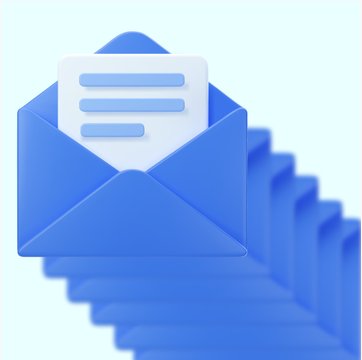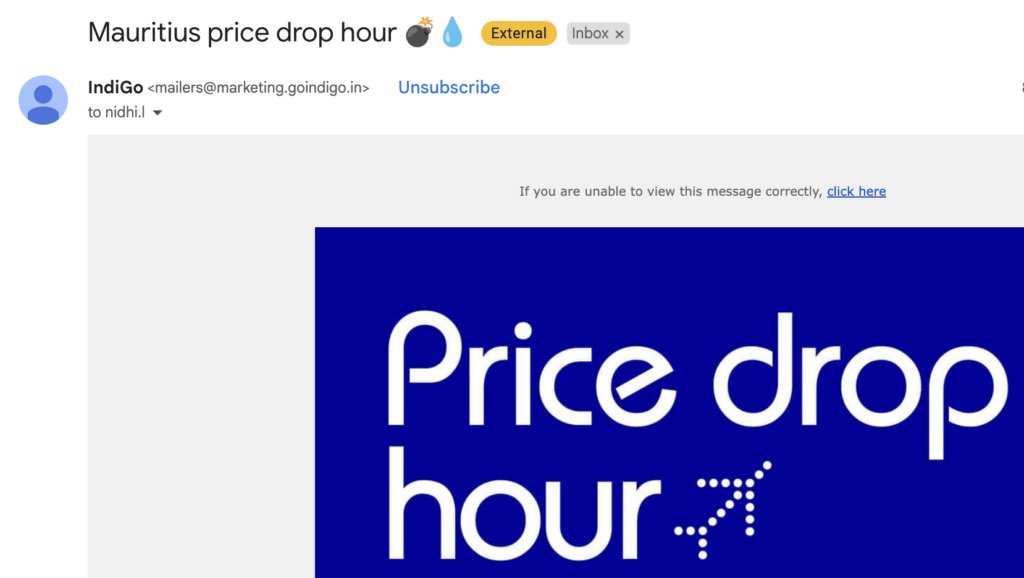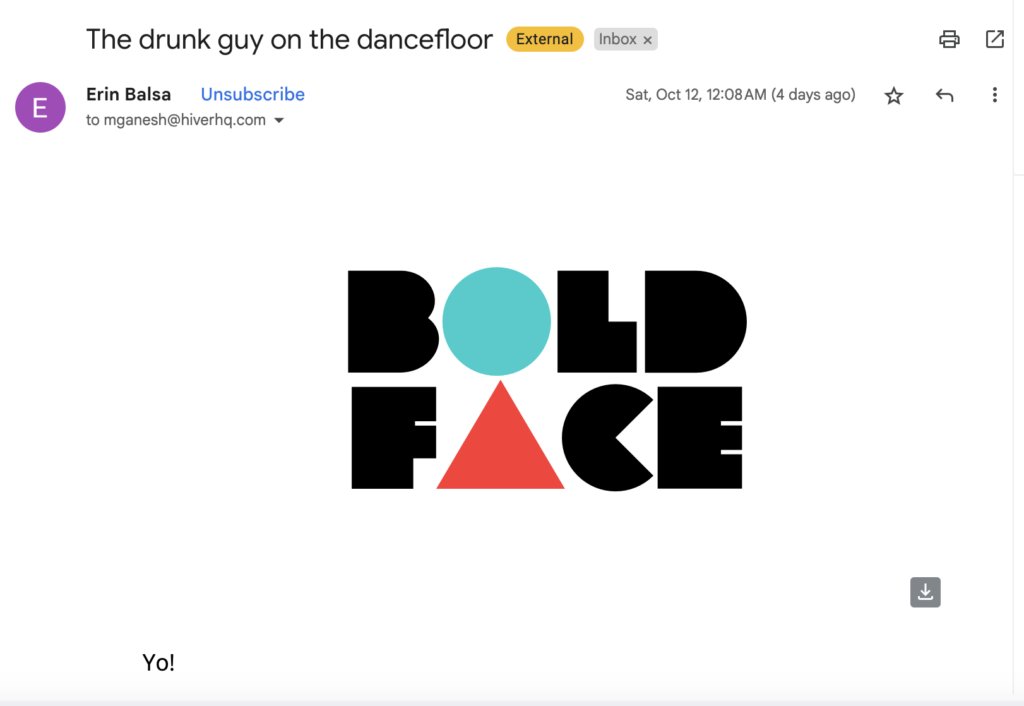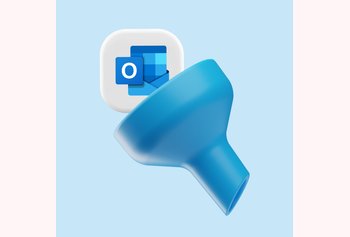6 Tips to Write Email Subject Lines That Get Engagement (+ 38 real-life Examples)

Table of contents
The single most important thing you can do to ensure that the emails you send are opened is to write a good subject line.
Think about it. The subject line is what you see in your notifications tab on your phone. It’s also the only part of your email visible when someone checks their inbox. It’s quite literally the deciding factor between an opened email and one that’s ignored or deleted.
Personally, it’s what I use to decide if an email I’ve received is worth my time. Because let’s be honest, I’m like everybody else out there, being peppered with emails and other notifications throughout the day. If you don’t catch the attention within two seconds, it’s over!
In fact, you can equate your email subject line to an elevator pitch during a super-short elevator ride.
All the numbers you care about—open rate, CTA conversion, sign-ups—hinge on those 60 characters that make up your subject line.
In this article, I’ll be breaking down what it takes to write a good email subject line and share tons of great examples you can use for inspiration.
Table of Contents
- Why is a good email subject line important?
- 6 best practices for writing a compelling email subject line
- 38 powerful email subject line examples to be inspired by
- Make Your Email Subject Lines Simple and Impactful
Why is a good email subject line important?
Before we get into the mechanics of writing good email subject lines, let’s go over why they’re so important.
- Boosts open rates – Since the subject line is the first (and sometimes only) impression you make, a well-crafted one can significantly increase the chances of your email being opened and read. Let’s look at an example of a weak subject line vs a strong one. Which one do you think is more likely to be opened – “Company Newsletter Issue 10” or “Exclusive: 6 Tips to Double Your Email Open Rates Today”?
In the second option, the reader is enticed with exclusive information and a promise of valuable tips that can have an immediate impact, making them more likely to open the email.
- Sets context/expectations – Another important benefit of subject lines is that they set context and expectations for what the recipient should expect from the email. You’re essentially providing clarity to the reader and letting them know why it’s relevant to them.
This actually ties back to the earlier point I mentioned – when recipients know what to expect, and it’s actually relevant to them, they’re much more likely to open and read your email.
- Helps avoid spam filters – A well thought-out email subject line also ensures that your email ends up in the recipient’s inbox and not their spam folder. Certain words and phrases trigger spam filters which are designed to block emails with misleading, overly promotional, or deceptive subject lines. But if you follow best practices (I’ll get to these in a second) and refrain from using spammy words like “Free” or “Urgent,” you can increase the chances of your email being seen by the recipient.
- Creates urgency – Certain subject lines create urgency in the recipient, which then drives them to open and engage with the email. For instance, if a university sends an email to an interested applicant with the subject line “Final Deadline for Fall Applications: Apply Today,” it immediately creates a sense of urgency and drives action.
Email subject lines also help you spark curiosity among your recipients. A subject line like “Unlock Your Scholarship Opportunities Now” will make the applicant wonder what specific scholarships might be available and will motivate them to click.
So, the goal isn’t just to get people to open your emails, it’s to drive action whether that is signing up to your webinar or increasing sales.
Now that we’ve established why you need to spend time and attention crafting a good subject line – let’s talk about how you can do this.
6 best practices for writing a compelling email subject line
The average email open rate across all industries is 37.72%. If you want your recipients to open your emails and act on them, follow these six best practices when crafting your next email subject line.
1. Keep it short and to the point
2. Personalize the subject line
3. Create a sense of urgency
4. Offer something valuable or interesting
5. Avoid using clickbait
6. Include relevant keywords
1. Keep it short and to the point
As I mentioned earlier, a subject line is like a very tiny elevator pitch for your email. You’ll want to be as precise as possible and you’ll have to get to the point immediately. An ideal range is between five to nine words.
Depending on which device you expect most of your users to be on when they receive your email, your subject line length will vary. For instance, if you’re a D2C business reaching out to individual customers, you’re most likely going to pop up as a notification on a phone screen.
Short subject lines are more likely to display fully and thus get your point across. On top of that, the brevity also avoids overwhelming the reader, making it easier for them to decide whether to open the email.
Recommended read: 12 Tips + Examples on How to Write a Professional Email
2. Personalize the subject line
Personalizing subject lines is important because it makes the email feel more relevant and tailored to the individual recipient, increasing the chances of them opening and engaging with it.
There are several ways to do this, but including the recipient’s name or past context is a good place to start.
For example, instead of a generic subject line like “Check Out Our New Features,” a personalized version could be “John, Discover Features Tailored for Your Business!” This approach grabs attention and makes the recipient more likely to engage with the content inside.
3. Create a sense of urgency
I addressed this earlier – if you want the recipient to not just open your email but actually act on it, you’ll want to create a sense of urgency in your email.
By using time-sensitive language like “today,” “limited time,” or “last chance,” you create FOMO (fear of missing out),which motivates readers to open the email right away.
For example, instead of saying, “Our Sale is Happening Now,” a more urgent subject line could be “Hurry! Only 24 Hours Left to Save Big!” This sense of urgency prompts the recipient to act quickly, boosting open and engagement rates.
4. Offer something valuable or interesting
An email subject line that highlights a clear benefit or offers something of value piques the recipient’s interest and gives them a reason to open the email. Whatever you’re offering, you’ll want to highlight why the recipient might find it valuable. If it’s a discount you’re offering, then talk about that. Or, if it’s a webinar they signed up for and were unable to attend, talk about how you’ve got a recording for them to catch up on.
To give you an example, if I were to send out a monthly newsletter to Hiver’s mailing list, instead of saying “Hiver’s newsletter for October,” I’d talk about what this month’s edition offers specifically. Something like – “Free research report on why finance teams struggle with email”.
Recommended read: 119 Email Phrases to Help You Get the Desired Response
5. Avoid using clickbait
It’s tempting to use clickbait in your subject lines because, initially, you might see an uptick in open rates. But here’s the thing—when you use a clickbait subject line, you’re baiting someone into opening your email by being misleading.
For example, let’s say you’re running a contest as a promotion, and the winner will win an iPhone. To increase participation, you send out an email with the subject line, “Congratulations! You’ve won an iPhone.” But when the recipient opens the email, they find details about the contest.
Sure, you’ll get a bunch of people to open your emails because they’re expecting an iPhone, but their expectations will be let down as soon as they open the email. You’ve over-promised in the subject line and severely underdelivered in the actual email. This erodes any kind of trust you’ve built with your subscribers.
You’d also be better off avoiding common spam trigger words in your email subjects to avoid sounding spammy.
6. Include relevant keywords
This tip is often overlooked, but including relevant keywords in your subject lines can help recipients organize and filter their inboxes more effectively. Many people, myself included, use specific keywords to categorize or locate important emails later. By incorporating terms related to your content, you make it easier for recipients to find your email when they need it again.
For example, if I have a monthly newsletter called “Cakes and Bakes,” and each edition covers a different topic, including the newsletter’s name in the subject line can help recipients stay organized. A subject line like “Cakes and Bakes: Delicious Fall Recipes” makes it easy for readers to locate the email later. If someone misses the email but wants to find it later, they can simply search for the newsletter name.
This will improve your open rates because not everybody has the time to check out newsletters the moment they receive them, and if the subject line is tricky, it can be hard to locate.
Next time you’re creating an email subject line, try these six simple tips—you’ll notice a significant improvement in how people engage with your emails.
38 powerful email subject line examples to be inspired by
Here are some email subject line examples by real-life brands you can use as inspiration when you’re working on your next email.
1. Create urgency and FOMO (fear of missing out)
Subject lines that create FOMO and urgency are highly effective in prompting immediate action. By making recipients feel like they might miss out on a limited-time offer or opportunity, you can drive quicker opens and higher engagement rates.
Here are some examples you can refer to to better understand what I mean –
- JetBlue: “You’re missing out on points.”
- J.Crew Factory: “Click it or miss it, people: Over 500 styles under $25 are ending!”
- Poshmark: “Your discounts EXPIRE SOON.”
- Uber: “Grab a ride pass before they’re gone”
- Dollar Shave Club: “We want to give you money.”
- Crate and Barrel: “2x the rewards, two brands, 5 days only.”
2. Ignite curiosity in the recipient
When I say ignite curiosity in the recipient, I mean your email subject line should pique their interest. It should hint that there’s something valuable or unexpected inside the email, prompting them to open it to satisfy their curiosity.
Let’s look at some examples of this –
- Refinery29: “10 bizarre money habits making Millennials richer”
- Indigo: “Mauritius price drop hour.”

- Ikea: “A surprise gift for you!”
- Intercom: “Are you making this landing page mistake?”
- LinkedIn: “This is how much working from home saves you.”
- Apartment Therapy: “Why You Should Keep Your Clothes in the Freezer”
- Digital Marketer: “Check Out My New ‘Man Cave’ [PICS]”
- Zillow: “The truth about moving expenses”
- Erin Balsa: “The drunk guy on the dancefloor.”

3. Be humorous and witty
Another great way to get people to read your emails is to be humorous and witty in your email subject line, which, let me tell you, is no easy feat. You have to really understand your audience and be a skilled writer to pull it off in 6-7 words.
When done right, humor can create a positive connection with the reader and make your message more memorable. Here are some examples to bring a smile to your recipients’ faces and boost your open rates.
- Eater Boston: “Where to Drink Beer Right Now”
- OpenTable: “Licking your phone never tasted so good.”
- The Muse: “We Like Being Used”
- Dollar Shave Club: “What to Do When You’re the Sweaty, Smelly Guy at the Gym”
- Crate and Barrel: “New planters? Oh, kale yeah.”
- Edgevale: “Get In Our Pants”
- Groupon: “Deals That Make Us Proud (Unlike Our Nephew, Steve)”
- Grubhub: “Breaking chews! We found new restaurants near you!”
4. Retarget disengaged subscribers
No matter how well you do with your email marketing, chances are you’ll see people stop engaging with your emails. Or maybe somebody checked out your website and dropped off or abandoned their cart.
In such cases, you send emails to grab their attention and get them back into the sales funnel. These emails are called retargeting emails. The subject lines you use for these emails are extremely important because they either have to be creative and eye-catching or an offer that tempts them to come back and engage with you.
Let’s look at some good examples –
- LinkedIn: “[Name], people are looking at your LinkedIn profile”
- Vail Resorts: “Come Back This Winter With an Exclusive Deal, [Name]”
- Target: “The price dropped for something in your cart”
- Airbnb: “Pick up where you left off”
- DollsKill: “We Saw You Checking Us Out 😏”
5. Lead with a question
Another common but powerful type of email subject line is one that leads with a question. Questions naturally engage the reader’s curiosity and prompt them to think about their own response, making them more likely to open the email to see how it aligns with their thoughts or needs.
A well-placed question can also make the subject line feel more conversational and personal. Here are some examples to inspire thought and encourage your audience to click through –
- Zillow: “What can you afford?”
- Grammarly: “Did you take a writing break?”

- BuzzSumo: “What backlinks are you getting?”
- Psychologies: “Do you play enough?”
- Sky: “Ready for some festival fun?”
- Pocket: “Can you snack your way to better sleep?”
- Sephora: “Want to try our best sellers for free?”
- Tidio: “Ready to boost your productivity by 50%?”
- LinkedIn: “Is this your next job?”
- Finance Alliance: “Struggling to get your forecasting and budgeting just right?”

Make Your Email Subject Lines Simple and Impactful
I hope by now you’ve got a much better understanding of how to create your email subject lines. To quickly recap, keep it short and direct and try to catch the recipient’s attention by either being witty or offering value. That’s really all you need to do. It’s not complicated, and once you get the hang of it, you’ll notice a marked improvement in your open rates and engagement.
If there’s one thing I’d like to leave you with, it’s this: although it’s only six to seven words, your email subject line is probably the most important part of your email and should be treated as such. So, spend time crafting one that you’d want to open yourself.

































